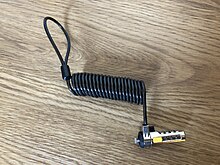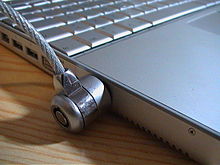Kensington Security Slot


The Kensington Security Slot (also called a K-Slot or Kensington lock) is an anti-theft system for hardware electronics such as notebook computers, computer monitors and others. It is a small, metal-reinforced hole used for attaching a lock-and-cable apparatus. It is produced by Kensington Computer Products Group.
Development
Designed in the mid 1980s[1] and patented by Kryptonite in 1999–2000,[2] assigned to Schlage in 2002, and since 2005 owned and marketed by Kensington Computer Products Group.[3]
Design

The system consists of a small, metal-reinforced hole found commonly on small or portable computers and electronics equipment such as laptops, computer monitors, desktop computers, video game consoles, audio interfaces, and video projectors, combined with a metal anchor attached to a rubberized metal cable secured with a key or combination lock. The end of the cable has a small loop that allows the cable to be looped around a permanent object, such as a heavy table or other similar equipment.[2]
The hole is found in many laptops, although a lock for it is typically not included. Occasionally, the slot is located so that installing a lock will also prevent the removal of a valuable subcomponent, such as a rechargeable battery or a memory module. The Kensington slot may be marked with a small icon that looks like a padlock with a capital "K", or the slot may be unlabelled.
Efficiency

Kensington locks can discourage opportunistic grab-and-run thefts of equipment from public locations such as coffee shops or libraries, but they are not designed to be impervious protection measures, nor are they intended to secure equipment in unattended locations,[3] because they can be torn out of equipment (although not without causing visible damage), given that the cases are typically made of plastic or thin metal, and the cable can be cut with wire or bolt cutters. In addition to this, successfully securing the non-locking, loop end of the cable is dependent upon the availability of a suitable anchoring point on a virtually immovable base object, or a thief may just shift that object, and then take the protected device with cable attached.
The lock mechanism is typically a tubular pin tumbler lock or, less frequently, a flat key lock or a numeric combination lock with no key.[3]
Alternatives
Several manufacturers offer similar locking mechanisms that do not require a special lock hole.[4] They attach to a popular port, such as the VGA or printer port, and have special screws to secure locks in place.
References
- ^ The Computer Chronicles, The Computer Chronicles - Notebook Computers (1992), archived from the original on 2021-12-22, retrieved 2018-12-13
- ^ a b Security anchor/tether assemblage for portable articles: U.S. Patent 6,081,9746,317,936 and 6,360,405 (Cornelius McDaid, John Ristuccia, Kryptonite Corporation - priority date: 1999-06-21)
- ^ a b c "Kensington SAFE Security Ratings". Archived from the original on 2011-09-03. Retrieved 2014-04-12.
- ^ "PA496U: Targus DEFCON® VPKL - Video Port Key Lock". Archived from the original on 2009-05-27. Retrieved 2014-04-12.
